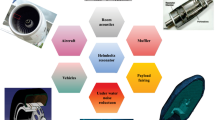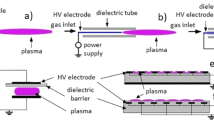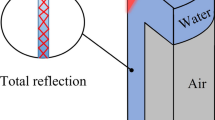Abstract
Accident-induced liver trauma is a significant human health concern, as this organ is readily injured during periods at which the abdominal region is compromised. In this work, electromagnetic thermotherapy was successfully developed and employed in vitro and in vivo to treat livers that had been lacerated. Briefly, a new hemostasis plug was integrated with an electromagnetic thermotherapy system (ETS) to perform surgery on lacerated livers. The high-frequency, alternating electromagnetic field (EMF) was generated by the ETS and was shown to induce a pre-set temperature increase within the hemostasis plug embedded in the target tissue. In order to prevent overheating and maintain a constant hemostasis temperature, a temperature feedback control system was utilized. The effect of the intensity of the EMF on the heating capacity of the ETS-hemostasis system was first explored. Furthermore, the relationship between the coagulation zone and operating temperature were investigated in vitro. By utilizing the temperature feedback control system, the hemostasis plug could be heated to a specific temperature for efficient hemostasis. With this approach, the optimal treatment temperature and time were investigated for liver laceration. Lacerated livers from New Zealand white rabbits were successfully treated with the hemostasis plug and ETS within a short period of time. When compared with the traditional perihepatic packing approach, the volume of blood loss from liver laceration surgeries treated by ETS has been dramatically reduced by 83%, suggesting a high therapeutic potential for this system.













Similar content being viewed by others
References
Abdalla, E. K., J. N. Vauthey, L. M. Ellis, V. Ellis, R. Pollock, K. R. Broglio, K. Hess, and S. A. Curley. Recurrence and outcomes following hepatic resection, radiofrequency ablation, and combined resection/ablation for colorectal liver metastases. Ann. Surg. 239(6):818–827, 2004.
Caruso, D. M., F. D. Battistella, J. T. Owings, S. L. Lee, and R. C. Samaco. Perihepatic packing of major liver injuries: complications and mortality. Arch. Surg. 134(9):958–963, 1999.
Chen, C. Y., R. Zuchini, H. W. Tsai, C. H. Huang, S. C. Huang, G. B. Lee, and X. Z. Lin. Electromagnetic thermal surgery system for liver resection: an animal study. Int. J. Hyperth. 26(6):604–609, 2010.
Clancy, T. V., J. Gary-Maxwell, D. L. Covington, C. C. Brinker, and D. A. Blackman. A statewide analysis of level I and II trauma centers for patients with major injuries. J. Trauma 51(2):346–351, 2001.
Demetriades, D., H. Gomez, S. Chahwan, K. Charalambides, G. Velmahos, and J. Murray. Gunshot injuries to the liver: the role of selective nonoperative management. J. Am. Coll. Surg. 188(4):343–348, 1999.
Demetriades, D., P. Hadjizacharia, C. Constantinou, C. Brown, K. Inaba, and P. Rhee. Selective nonoperative management of penetrating abdominal solid organ injuries. Ann. Surg. 244(4):620–628, 2006.
Flanagan, T. B., B. S. Bowerman, and G. E. Biehl. Hysteresis in metal/hydrogen systems. Scr. Mater. 14(4):443–447, 1980.
Harold, B. G., C. N. Hoyler, and R. A. Bierwirth. Theory and application of radio-frequency heating. New York: D. Van Nostrand Company Inc., 1947.
Huang, S. C., Y. Y. Chang, Y. J. Chao, Y. S. Shan, X. Z. Lin, and G. B. Lee. Dual-row needle arrays under an electromagnetic thermotherapy system for bloodless liver resection surgery. IEEE Trans. Biomed. Eng. 59(3):824–831, 2012.
Jais, P., M. Haissaguerre, D. C. Shah, S. Chouairi, L. Gencel, M. Hocini, and J. Clementy. A focal source of atrial fibrillation treated by discrete radiofrequency ablation. Circulation 95(3):572–576, 1997.
Lin, T. Y. A Simplified Technique for Hepatic Resection: The Crush Method. Ann. Surg. 180(3):285–290, 1974.
Madding, G. F., and W. H. Peniston. Liver hemostasis. Surg. Gynecol. Obstet. 104(5):417–424, 1957.
Matthes, G., D. Stengel, J. Seifert, G. Rademacher, S. Mutze, and A. Ekkernkamp. Blunt liver injuries in polytrauma: results from a cohort study with the regular use of whole body helical computed tomography. World J. Surg. 27(10):1124–1130, 2003.
McGahan, J. P., and G. D. Dodd. Radiofrequency ablation of the liver. Am. J. Roentgenol. 176(1):3–16, 2001.
Millikan, J. S., E. E. Moore, G. E. Moore, and R. E. Stevens. Alternatives to splenectomy in adults after trauma: repair, partial resection, and reimplantation of splenic tissue. Am. J. Roentgenol. 144(6):711–716, 1982.
Patterson, E. J., C. H. Scudamore, D. A. Owen, A. G. Nagy, and A. K. Buczkowski. Radiofrequency ablation of porcine liver in vivo: effects of blood flow and treatment time on lesion size. Ann. Surg. 227(4):559–565, 1998.
Saifi, J., J. B. Fortune, L. Graca, and D. M. Shah. Benefits of intra-abdominal pack placement for the management of nonmechanical hemorrhage. Arch. Surg. 125(1):119–122, 1990.
Shan, Y. S., R. Zuchini, H. W. Tsai, P. W. Lin, G. B. Lee, and X. Z. Lin. Bloodless liver resection using needle arrays under alternating electromagnetic fields. Surg. Innov. 17(2):95–100, 2010.
Van, Z. J. Heating the patient: a promising approach? Ann. Oncol. 13(8):1173–1184, 2002.
Voutsalath, M. A., C. K. Bichakjian, F. Pelosi, D. Blum, T. M. Johnson, and P. M. Farrehi. Electrosurgery and implantable electronic devices: review and implications for office-based procedures. Dermatol. Surg. 37(7):889–899, 2011.
Walt, A. J. The mythology of liver trauma, or Babel revisited. Am. J. Surg. 135(1):12–18, 1978.
Acknowledgments
The authors would like to thank the Southern Taiwan Science Park, Ministry of Science and Technology, Taiwan (STSP 102CP01) for partial financial support of this project. The authors would also like to thank Shuen-Fong Chen, Kuan-Cheng Chen and Chi-Ming Ho for assisting with the liver laceration surgery on animal models.
Author information
Authors and Affiliations
Corresponding authors
Additional information
Associate Editor Jennifer West oversaw the review of this article.
Rights and permissions
About this article
Cite this article
Liu, CH., Huang, SC., Chao, YJ. et al. Hemostasis Plug for an Electromagnetic Thermotherapy and Its Application for Liver Laceration. Ann Biomed Eng 44, 1310–1320 (2016). https://doi.org/10.1007/s10439-015-1365-9
Received:
Accepted:
Published:
Issue Date:
DOI: https://doi.org/10.1007/s10439-015-1365-9




